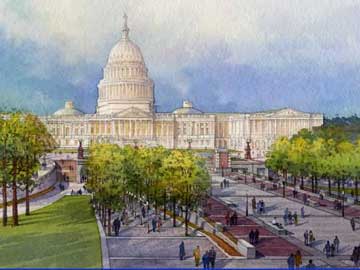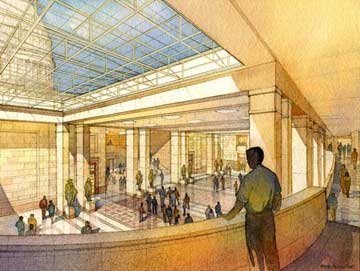 By BARBARA BARRETT McClatchy Newspapers March 29, 2006
Try to get something done in Washington, and there's a good chance it will take longer and cost more than anyone ever imagined. Consider the subterranean visitor center being built in the bowels of the Capitol. The project is nearly $300 million over budget and more than two years behind schedule. There have been scads of construction upgrades, congressional committee hearings, a scathing report from the Government Accountability Office and - this being America - even a lawsuit about the truckloads of rock being placed inside.
As a result, the Capitol Visitor Center is - again - not ready as Washington kicks off its springtime tourism season. In Congress, it seems, nothing comes easily. "We've got 535 people we respond to," said Thomas Fontana, spokesman for the Capitol Visitor Center, counting up the senators and representatives. The idea behind the center, percolating since the 1990s, was simple: Funnel Capitol visitors through a security checkpoint well away from the building. Let them wait for their tours in air-conditioned comfort. But do it all without destroying the historic views. Once the center is finished, visitors will go underground 300 yards from the Capitol's front door. Inside, they'll be able to watch a film and read historic documents, buy lunch and visit a gift shop. But in a way, the center will separate the public from the building it owns. Visitors will still be able to tour the Capitol, but they will no longer ascend the steps leading inside to the rotunda. And that's troubling when the point of the steps' architecture is to affect visitors, said Judy Scott Feldman, an art historian and chairwoman of the National Coalition to Save Our Mall. "As you ascend, you find yourself preparing to be in the seat of this grand democracy," she said. "If, instead, a visitor goes underground, you might learn a lot, but the power of the architecture will be lost." For now, the site is a vapor of dust ringing with the noises of electric saws, beeping forklifts and the gruff chatter of work crews. Walking through the site, Fontana spoke quickly, animated under his white hard hat, giving the spiel he delivers routinely for journalists, architects and members of Congress. He had poster boards of artist renderings strategically placed about the site so he could show that here, where the guy in a welding helmet works, is a future glass floor. It will be lit from beneath. And here, where the forklift is slowly lowering a 300-pound block of sandstone, is the balustrade. Someday, tourists will be able to peer through a skylight at the Capitol dome. The sandstone, about 52,000 pieces of it from 14 states, has caused problems. The work site was supposed to be getting 10 to 12 shipments a month for the center's floors and walls. But the pace dwindled last fall. A lawsuit questions who's responsible, and Fontana can't really talk about it. But a report from the Government Accountability Office said maintaining stone deliveries is crucial to getting the project finished. As it is, the center will cost at least $556 million, and possibly upward of $584 million, the GAO said. That's more than twice the original budget of $265 million. The center was scheduled to open in time for the presidential inauguration in January 2005. Now, Fontana said, it might be April of next year. The GAO suspects it is even further off. The overruns are not, perhaps, a surprise for Congress, a body known for having trouble keeping spending under control. Just as lawmakers pad the federal budget with special-project earmarks, they kept adding on to the visitor center. Congress kicked the project into gear after the shooting deaths of two Capitol police officers near a visitor's entrance in 1998. Then came the Sept. 11, 2001 attacks. Congress wanted more security, worth another $140 million. Then members wanted to add underground offices and meeting space. Another $88 million. And the backups continue. In February, Congress learned it will take 4 1/2 months just to test the center's fire safety system. "They don't want to cut corners," Fontana said. "They want to do it right." But they're still being watched. Another congressional hearing is scheduled for April.
Scripps Howard News Service, http://www.shns.com Publish A Letter on SitNews Read Letters/Opinions
|
||

